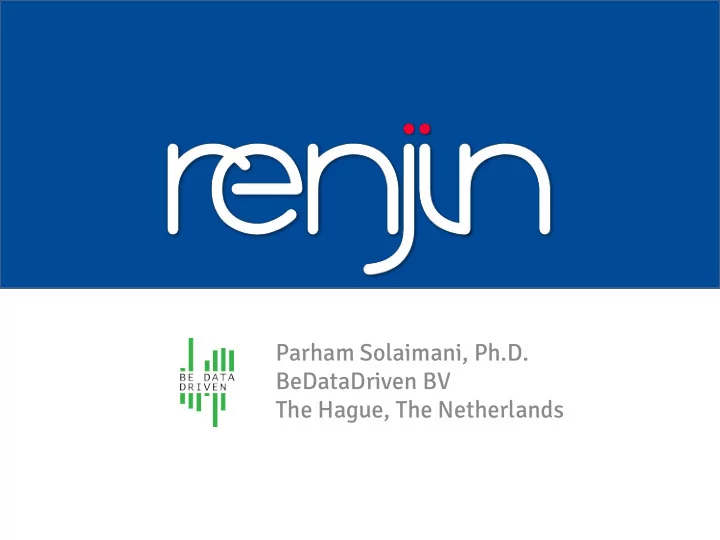

Parham Solaimani, Ph.D. BeDataDriven BV The Hague, The Netherlands
What is Renjin R interpreter in Java running in JVM ● Run and scale with could Platform-as-a-Service Use Enterprise Integrate into existing Development Environment Java applications
R on cloud Platform-as-a-Service reflection.io ● R model predicting app revenue (statistician) ● Java-based platform on Google AppEngine (developers) Other examples ● Yodle : Deploy R based statistical models directly into production without having to rewrite into Java ● Renjin AppEngine Demo : renjindemo.appspot.com
Renjin on Spark cluster RABID: Spark + Renjin / GNU R ● Fault tolerance, efficiency, low overhead and minimized network transfers “ it [Renjin], like Spark, is implemented in Java, and consequently can be better integrated with Spark ” Lin H., et al . 2014, IEEE Int. Congress on Big Data . Others ● Spark+Renjin used by Apple in production cluster (of 1000 nodes) ● REX: Apache Spark Renjin Executer (on github)
R in existing Java applications OrbisGIS An Open Source Geographic Information System Lab-STICC – CNRS Renjin as R console to allow statistical analysis of GIS information SciJava Renjin module : Provides a scripting plugin for Renjin interpreter to tools such as ImageJ, KNIME, CellProfiler, OMERO and others. SciCom : SciCom is a JRuby gem that allows very tight integration between Ruby and R languages. icCube : Business Intelligence tool with R integration provided by Renjin
Compatibility Performance
Approach to Compatibility ● Support major dependencies ○ S4 object system, Rcpp, MASS, etc. ● Improvement of Renjin development and testing environment ● Measurement and tracking of compatibility over time
Development environment ● Real-world with real data bioInformatics workflow (renjin-benchmarks) ● Automated test-case generation (based on testr) ● Renjin dashboard ● Goals: − Reduce time-to-answer for workflows − Reduce developer time required for performant solutions.
GNU R Compatibility BioC CRAN Renjin all tests > 1 test 1 test % Packages % Packages Sinds 1st January 2016 Builds ~ 250 Compiles ~ 800 Passing tests > 9000
Performance. renjin.org
Trends Package Sources Overall Statistics R C C++ Fortran CRAN 17.16 8.84 5.24 1.84 BioConductor 2.50 1.86 1.71 0.02
Compare: Vector Loops Operations x <- 1:1e8 x <- 1:1e8 S <- 0 s <- sum(sqrt(x)) for(i in x) s <- s + sqrt(i) ~ 10 R expressions ~ 300m R expressions evaluated evaluated renjin.org
Function Lookup → Function selection → Boxing → Function Call package:base + = .Primitive(“+”) s <- 0 sqrt = .Prim(“sqrt”) for (i in 1:1e8) { package:grDevices s <- s + sqrt(i) } package:methods print(s) package:utils package:stats Function Lookup Global Environment renjin.org
Function Lookup → Function selection → Boxing → Function Call package:base + = .Primitive(“+”) sqrt = .Prim(“sqrt”) s <- 0 package:grDevices class(s) <- “foo” for (i in 1:1e8) { package:methods s <- s + sqrt(i) } package:utils print(s) package:stats Function Lookup Global Environment renjin.org
Function Lookup → Function selection → Boxing → Function Call 1 Two double-precision values stored in Boxing/Unboxing of Scalars a register can be added with one processor instruction s <- 0 for (i in 1:1e8) { 1000s s <- s + sqrt(i) SEXPs live in memory and must } be copied back and forth, print(s) attributes need to be computed, etc. requiring 100s-1000s of cycles. renjin.org
Function Lookup → Function selection → Boxing → Function Call TODO s <- 0 1. Lookup cube symbol cube <- function(x) x^3 2. Create pair.list of promised arguments for (i in 1:1e8) { 3. Match arguments to closure's formals s <- s + cube(i) pair.list (exact, partial, and then } positional) 4. Create a new context for the call print(s) 5. Create a new environment for the function call 6. Assign promised arguments into Function Calls are Expensive environment 7. Evaluate the closure's body in the newly created environment. renjin.org
Transform to SSA B1: z ₁ ← 1:1e6 s ₁ ← 0 i ₁ ← 1L s <- 0 z <- 1:1e6 temp ₁ ← length(z) for(zi in z) { s <- s + sqrt(zi) } B2: s ₂ ← Φ(s ₁ , s ₃ ) i ₂ ← Φ(i ₁ , i ₃ ) if i ₂ > temp ₁ B4 Assumptions recorded: ● “for” symbol = Primitive(“for”) ● “{“ symbol = .Primitive(“{“) B3: zi ₁ ← z ₁ [ s ₂ ] ● “+” symbol = Primitive(“+”) temp ₂ ← sqrt( zi ₁ ) ● “sqrt” symbol = Primitive(“sqrt”) s ₃ ← s ₂ + temp ₂ i ₃ ← i ₂ + 1 goto B2 B4: return ( zi ₁ , s ₂ ) renjin.org
Comparing Workarounds GCC (Human) C/C++ Interm. R X86 Function Rep. (IR) Renjin Loop Compiler JVM R IR X86 Bytecode renjin.org
Statically Computing Bounds ● We've computed types for all our variables ● Identified scalars that can be stored in registers ● Propagated constants to eliminate work ● Selected specialized methods for “+”, “sqrt” renjin.org
Timings f <- function(x) { s <- 0 for(i in x) { s <- s + sqrt(i) } return(s) } f(1:1e6) f(1:1e8) GNU R 3.2.0 0.255 25.637 + BC 0.130 12.503 Renjin+JIT 0.107 0.355 renjin.org
Timings f <- function(x) { s <- 0 class(x) <- "foo" for(i in x) { s <- s + sqrt(i) } return(s) f(1:1e6) f(1:1e8) } GNU R 3.2.0 0.675 69.046 + BC 57.466 Renjin+JIT 0.107 0.367 renjin.org
Timings halfSqr <- function(n) (n*n)/2 f <- function(x) { s <- 0 for(i in x) { s <- s + halfSqr(i) } f(1:1e6) f(1:1e8) return(s) } GNU R 3.2.0 28.284 278.757 + BC 26.179 - Renjin+JIT 0.117 1.069 renjin.org
Comparison with GNU R Bytecode Compiler ● Compilation occurs at runtime, not AOT: − More information available − (Hopefully) can compile without making breaking assumptions f <- function(x) x * 2 g <- compiler::cmpfun(f) `*` <- function(...) "FOO" f(1) # "FOO" g(1) # 2 renjin.org
Next Steps ● Continue work on compatibility with GNU R / BioConductor ● Expand and continue profiling benchmark library ● More in depth analysis of CPU, (cache) memory, disk usage by benchmarks ● Extend impliciet optimizations
Questions?
Recommend
More recommend